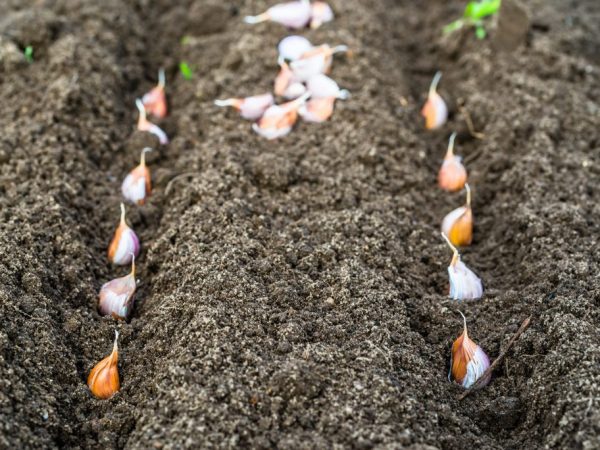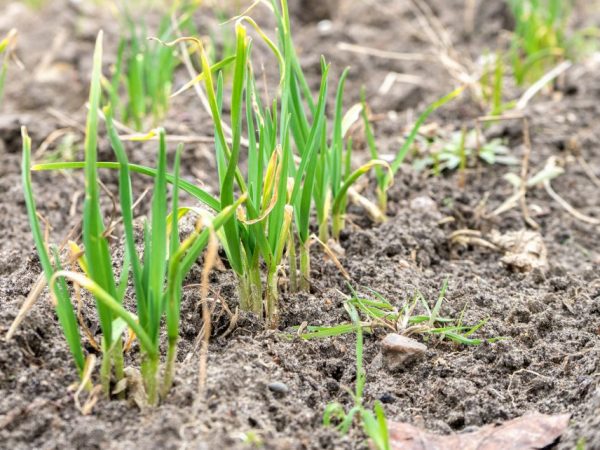When is it better to plant garlic in the Urals
Gardeners living and gardening in the Urals, especially in the northern regions, should be smart about choosing a garlic variety. The selected variety must fully comply with the climatic conditions of the region in 2018. It is also important to know exactly when garlic is planted in the Urals. More recently, there were no spring varieties of garlic, which are intended to be grown in harsh climatic conditions, and gardeners were forced to sow winter varieties. For the northern part of the Urals, the best variety is the one that throws out an arrow with an inflorescence, because this species is considered winter and it is more resistant to low air temperatures.

Planting garlic in the Urals
Suitable varieties of garlic for the Urals
The main territory of the Urals has a climate where very cold winters are replaced by sultry and short summers. Given this situation, it is necessary to correctly calculate the time when it is better to plant plantings in open ground and which variety of winter or spring garlic to choose.
Varieties for the north of the Urals
- Nazus
- Vyatsky
- Amethyst
- Azure
Varieties for the south of the Urals
- Victorio
- Gulliver
- Dobrynya
- Gribovsky jubilee
- Lyubasha
The southern part of the Urals has a fairly stable climatic regime; therefore, any varieties, including spring varieties, can be planted on this territory. It is recommended to consult a specialist before choosing a variety of garlic for planting.
Landing dates
The time when you need to plant garlic in open ground depends entirely on the climate in one or another part of the Urals. For the northern part of the Urals, planting begins in the middle of the second decade of September, but if it starts getting colder earlier, it is worth planting garlic before the first noticeable frost. As for the southern part of the Urals, the timing and time completely depend on the weather, but as a rule, the landing is made closer to mid-October. When we plant garlic, it is very important to take into account the state of the temperature regime. Also, many gardeners rely on folk signs and thus determine the optimal timing.
Folk omens
- Planting of garlic is carried out from the moment the birds migrate to winter mode in warm regions.
- You can plant garlic when your fingers start to freeze on the street.
- If the soil has cooled to such an extent that it is cold to stand on it with bare feet, then this means that you can start sowing.
Lunar landing
If you look at the lunar calendar, you can see that the most suitable time for landing is mid-August. The timing of the lunar calendar may vary slightly, but we plant the planting material no later than the period from August to September. For the cultivation of garlic to be successful, you need not only to take into account the dates according to the lunar calendar, but also to comply with the necessary requirements for the care and cultivation of your plantings.Due to the fact that the climate is gradually changing, few people observe the landing dates according to the lunar calendar. To get a good harvest, it is worthwhile to correctly calculate the time for growing planting material. That is, to have time to make a landing before the onset of stable cold weather.
Landing in open ground is done about 30-35 days before the ground begins to freeze. This is done so that the planting material can sprout roots, but does not seek to hatch out of the ground.
You also need to take into account what kind of culture grew in the soil before planting the seeds. You need to be very careful that garlic should not be planted in one place for two years in a row. The bed rest is about 3-4 years. Unfavorable soil is the soil where onions and other root crops used to grow. There are also crops after which the cultivation of garlic is recommended - these are cucumbers, eggplants, peppers and pumpkin. If you plant garlic in a garden bed, where previously favorable crops grew and at the same time observe the terms according to the lunar calendar, you can get a plentiful and healthy harvest.
Preparing garlic for planting

Plant the garlic with cloves
Spring garlic is planted by dividing the head into separate cloves, but winter garlic can be used in two types of planting material, it can be both cloves and seeds that ripen on the arrow. When propagated by seeds, it will take two years for the head to fully mature, and when multiplied by cloves, a formed head grows the very next year.
But no matter what method of reproduction is chosen, it is necessary to correctly prepare the planting material. In order for the planting material to subsequently give a good and healthy harvest, disinfection should be carried out immediately before planting in the ground. First of all, you should deal with the bulkhead of the cloves, remove damaged seeds and dried ones, with decay and very small ones. Then you should soak the planting material in the appropriate order in the following solutions:
- In a salt solution - at the rate of 3 tablespoons per 5 liters of water. Leave the seeds in it for 2 minutes.
- In a solution of copper sulfate - 1 tablespoon per 10 liters of water. Soak the seed in the solution for 1 minute.
But these two procedures can be replaced by one, in the presence of furnace ash. To do this, pour 400 g of ash with two liters of water, then boil everything for 30 minutes and cool. In the prepared and cooled solution, you need to soak the seeds for 2 hours.
Soil preparation
Plays a huge role for a rich harvest, fertilized and fertile land. Soils with a high content of sand or drainage are most suitable for this. Too acidic and heavy soil can significantly reduce yields. To remove acidity, lime is added to the soil at the rate of 1 glass per 1 square meter. You can also increase soil drainage by adding river sand to it.
Before planting the planting material in open ground, you need to dig up a piece of land for planting to a depth of 20-25 cm in about 2-3 weeks. The soil should not be deeper.
In the process of digging, you need to fertilize the ground at the rate of 5-6 kg of humus per 1 square meter of the plot. In no case should the soil be fertilized with fresh manure, this threatens the death of planting material or a significant decrease in yield. After digging and fertilizing, the area is watered with a saline solution at the rate of 1 glass of salt per 1 bucket of water and covered with polyethylene before planting begins.
Landing rules
When to plant garlic for the winter in the Urals? When planting planting material for autumn and winter, the planting schedules corresponding to the region in which the work is taking place must be followed. When you decide on the timing of planting, both in the southern and northern Urals, you can start planting planting material.On pre-prepared soil, you need to make grooves about 10-15 cm deep and a row spacing of at least 15 cm. Planting garlic in the fall in the Urals should be carried out according to all requirements, otherwise the plants cannot be protected from early decay.
The teeth themselves in the groove are planted so that the distance is at least 10 cm between them. At the end of planting, the filled grooves should be compacted so that the teeth take root faster and an air cushion does not form. The first watering is done after the soil is completely dry. Then mulching is done. For the northern regions of the Urals, mulching will not be enough, so gardeners have to cover the garden for the winter with improvised means or agrofibre.
Garlic care
Planting and growing garlic in the fall in the Urals is not difficult, and if you follow the basic rules, you can dig a good and bountiful harvest even from a small plot in a cold region. If for the winter the bed was covered with insulation, then, accordingly, all work begins only in spring. After the snow has melted, the soil should be loosened, but not deeply, so the young roots are saturated with oxygen.
In the spring, planting is watered as the soil dries. At the very beginning, you need to control so that the soil is constantly moistened. As it ripens, watering is reduced and already 3-4 weeks before harvesting, the plantings are not watered. Otherwise, excessive moisture can lead to premature rotting of the harvested crop. It is necessary to ensure that weeds do not grow on the beds. To save time on watering and weeding, the garden bed should be mulched. Mulching retains moisture and prevents weeds from germinating.
Fertilization procedure
If the fertilization of the soil for the winter was carried out in due order, then in the fall there is no need for additional fertilization. Only with the onset of spring will it be necessary to feed the kidney for three visits or more.
- After the snow melts, the soil should be watered with the prepared urea solution. The solution is prepared as follows: 1 tablespoon per 1 bucket of water at the rate of 2 liters per 1 square meter.
- 14 days after the first feeding, nitrophoska is applied in a proportion of 2 tablespoons to 1 bucket of water. Fertilizers are produced at the rate of 4 liters of the prepared mixture per 1 square meter.
- Around the middle of summer, a month before the start of harvesting, superphosphate should be applied to the soil. The solution is prepared in a proportion of 2 tablespoons per 1 bucket and is introduced into the ground at the rate of 4 liters per 1 square meter.
Those gardeners who prefer to fertilize the soil with natural products can use rotted manure. When all the rules of plant care are followed, good yield and quality are guaranteed.


